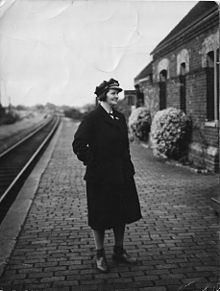Grid reference SP713305 | Area Aylesbury Vale 1 March 1878 Opened Platforms in use 1 | |
 | ||
Post-grouping London, Midland and Scottish RailwayLondon Midland Region of British Railways | ||
Padbury railway station served the village of Padbury in the English county of Buckinghamshire. It opened in 1878 as part of the Buckinghamshire Railway's branch line to Verney Junction which provided connections to Banbury, Bletchley and Oxford and closed in 1964.
Contents
History
The Buckinghamshire Railway's line from Banbury to Verney Junction opened to passengers on 1 May 1850. It had been originally planned to provide a station to serve the Buckinghamshire village of Padbury at a projected cost of £3,000 (£NaN in 2017) but this did not materialise, possibly as a result of necessary economies. It was not until 1 March 1878 that a station was opened at Padbury. The London and North Western Railway, which had worked the line from its opening and which absorbed the Buckinghamshire Railway in 1879, advised the Board of Trade in January 1878 that a station was being built at Padbury and that a siding had been laid to facilitate construction. The points to the siding were locked and an Annett's key was held by the Verney Junction stationmaster from whom it had to be collected and returned after each working to the siding.
A simple single storey red brick station building with a gable roof was provided at Padbury. No provision was made for the stationmaster who was expected to live in one of the nearby houses, as was the case for the Banbury Merton Street's stationmaster. As with Farthinghoe railway station, the station had a single platform, 250 ft (76 m) long, but unlike Farthinghoe it was conveniently situated to the west of the village of 650 inhabitants that it served. The station's siding ran in to the station forecourt to a point adjacent to the main station building; nearby were a cattle landing, weighbridge and hut. The siding, which was controlled by a six-lever ground frame and was released by an electric token, accommodated four or five coal wagons a week, together with milk traffic for the United Dairies factory in Buckingham and the village's requirements.
Padbury ceased to have its own stationmaster in 1928 upon the retirement of Levi Ambler. The station then came under the control of the stationmaster at Buckingham railway station who gave instructions to the remaining staff consisting of a single porter and junior assistant. From 1942 the station's staff consisted of a single lady porter, Bertha Allen, who was employed by the London, Midland and Scottish Railway (LMS) as temporary wartime cover, but instead remained for a further twenty-four years until the station's closure. In 1960, the section of the line between Banbury and Buckingham was closed, with the remaining section lasting four more years. Padbury station was listed for closure by the Beeching report and it duly closed to goods on 6 January 1964 and to passengers on 7 September 1964. The track was however not removed immediately and Padbury was thus able to accommodate the Royal Train for an overnight stay on 3/4 April 1966 for a visit by the Queen and the Duke of Edinburgh to Buckingham.
Present day
The station buildings were demolished in 1968 and the site was cleared. By 1975, construction of a small housing estate had commenced which now occupies the site. Just south of Padbury station a skew bridge took the line over Main Street which led into the village; no trace of this bridge remains. The course of the line to the north of the station followed a shallow cutting which is now infilled and returned to agriculture.
